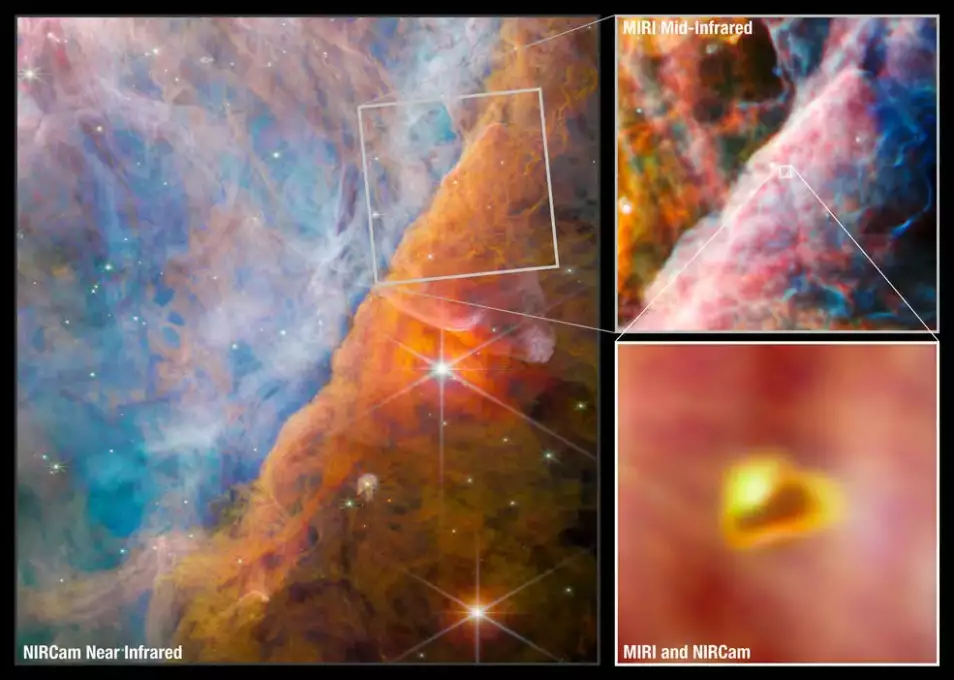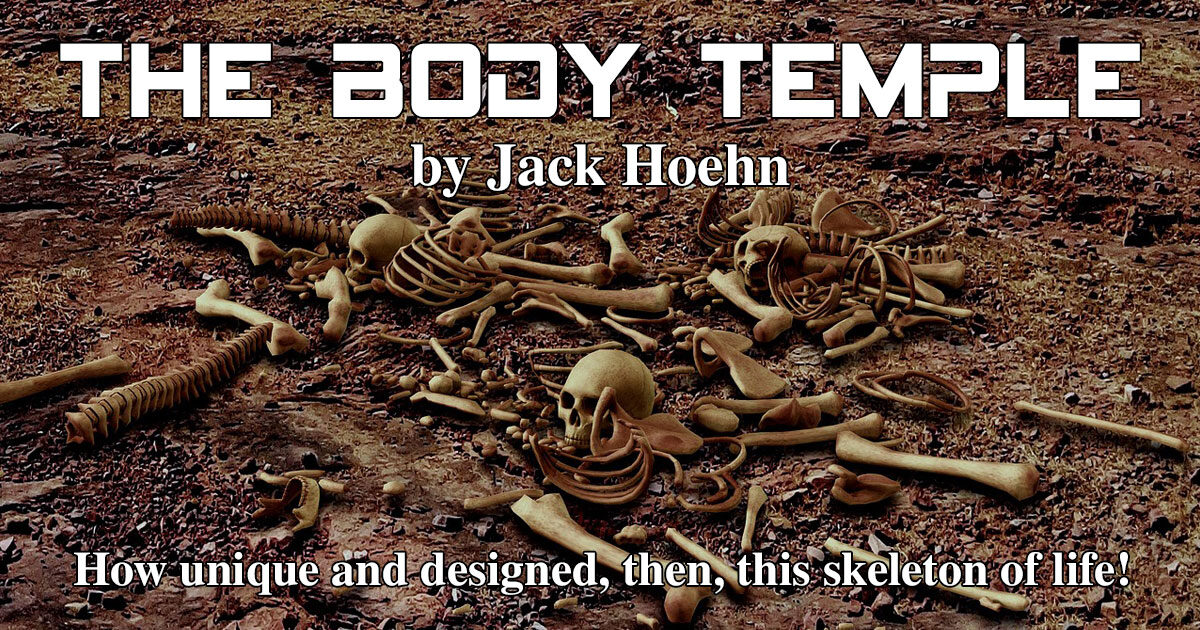These Bones
by Jack Hoehn | 19 March 2025 |
“Prophesy to these bones and say to them, ‘Dry bones, hear the word of the Lord!”
Ezekiel 37:4

Photographs of the creation of the elements used for life are coming to computers near you from the James Webb space telescope. This photograph is Orion, a constellation beloved by Adventists. The area outlined in the left side by a white box is enlarged in the top and bottom boxes on the right. The little yellow looking like a small wedding ring in the lower right is the new star being formed. Spectroscopy from this star shows that chemicals are being created there never before seen in space, but necessary for life chemistry. [1]
How does it see chemicals? The Webb space telescope has instruments that stretch out the light from stars the way a prism makes a rainbow from the sunlight. Each element when heated (like in a hot star) has a particular pattern in that spectrum. The illustration below demonstrates the unique patterns made by excited oxygen, carbon, nitrogen, neon, magnesium, or silicon chemical elements. So the Webb telescope’s instruments can look at the light coming from newly created stars and identify the chemicals in those stars.
Hidden Structure

So we now can observe throughout the universe how the “dust of the earth” was created. These elements form the molecules used for carbon-based life on this earth. Most scientists are convinced they will find life in other places in the universe than on Earth. Believers and Bible readers, of course, do not have a problem with the Creator’s creating other intelligences. There are many hints of non-human intelligences in the Bible. And our Adventist visionary tradition has created extra-Biblical “Eden-like” visions of “other planets.”
How did Adam know about bones?
I am not sure how a pre-fall Adam eating a vegan diet in a no-death Eden knew about bones. But when given his “half side” back (it wasn’t a rib) as his woman life-partner, scripture has him cry out in delight, “Here at last is bone of my bones and flesh of my flesh” (Genesis 2:23).
He was right, of course; his love, he himself, and all the mammals he had been naming had some sort of hidden inner bony structure.
In the end our soft tissues are fairly quickly disposed of by the bacterial, molds, fungi, and virus worlds. Mostly, our bodies quickly obey God’s prophecy, “To dust you shall return.” Bones and teeth resist the longest. The last shadows of a life are femurs, knuckles, and jaws.
Living Bone
How unique and designed, then, this skeleton of life! It is life’s structure and support and again is designed to multitask for efficiency and compactness of design. Bones make it possible for us to move quickly—without bone we could perhaps flow like a slug or amoeba or slowly roll, but climbing, running, walking, and playing would be impossible without bones. Bone is not solid like a rock but is engineered with a honeycomb-like matrix allowing it to be strong and rigid but also light. Bone is very much alive with blood vessels, nerves, and cartilage, and in the marrow factories forming the cells of the blood. Although replacing itself more slowly than stomach lining or other soft organs, the bone does constantly remodel and refresh itself every 10 years or so. However, when injured you don’t have to wait for 10 years; bone suddenly accelerates and will heal in days and weeks.
Flexible like “baby toothpaste”
Babies need to be very flexible in order to be squeezed out sort of like baby toothpaste from the mother’s womb through the birth canal, so they have 300 little bones that are not firmly attached to each other, which then after birth grow together to the 206 named bones of the adult. The smallest is the delicate little stapes in your middle ear, and the largest is your upper leg femur. The tiny stapes is 3 mm long and weighs 3.34 mg. The femur is 87,000 times heavier (290 g.).
Both are made of 30% collagen fibers mineralized for the 70% with specific forms of calcium phosphate. There are five differently designed types of bones. The long bones with a shaft, the short bones allowing supported movement at wrists and ankles, the flat bones of the skull and sternum (breastbone), the little sesamoid bones making tendons and muscles work correctly, and then the different from all the rest–vertebrae and pelvic bones creatively known as “other” or “irregular” bones. (But as far as I can tell, the vertebrae all consider themselves very “regular,” and all the other bones as irregular or “just plain weird” bones!)
If you think it is possible for 206 unique bones to evolve by “survival of the fittest,” and all the mammals that didn’t have good bones and couldn’t run away so were eaten by those predators who had first to evolve bones allowing them to chase them, then please explain to me the mechanism of evolution of the ends of bones called joints with the other unique creation called cartilage.
“Thigh Bone Connected to the Hip Bone”
A surface that is 200 times slicker than Teflon
You know from that spiritual song about Ezekiel 37, those dry bones had to become connected to each other? So shall we use a hinge, or a rope, or a ball and socket? Yes, we shall use all of these types of connections, but all of them carefully designed and with unique materials. Do you know that the shoulder joint, sort of a ball-and-socket mechanism, is lined with a surface that is 200 times slicker than Teflon? That was some “lucky mutation!” And what if we wanted to have these joints self-lubricating? How shall we mutate and select for that?
The self-lubricating synovial joints have a fluid with hyaluronic acid, lubricin, proteinases, and collagenases to
reduce friction;
absorb shock like a
shock absorber;
replace the blood and red cells
to bring the necessary oxygen and take away wastes from the cartilage tissue in the joints without red cells!
Wow, that is one fantastic fluid.
And how nice that the joint capsule tissues also have functions in them to
fight infections
of the joint if germs get in.
And if that weren’t enough, joint fluid itself is quite unique in its physics. It refuses to follow Newton’s laws of viscosity. It is a non-Newtonian fluid that behaves differently depending on the stresses placed on it. Under sudden increase of stress it miraculously becomes more viscous, working less like a lubricant and more like a shock absorber. Wouldn’t it be convenient if your car could use just one type of lubricant in its engine, air-conditioning compressor, brakes, power steering, and shock absorbers, that would adjust in each situation to the different viscosity needs? Impossible, of course—except when it is called synovial or joint fluid, and it does exist in all your joints.
Let’s give Sir Isaac Newton himself the last word on bones and joints with their “non-Newtonian” fluids.
“How came the bodies of animals to be contrived with so much art, and for what ends were their several parts? Was the eye contrived without skill in optics, and the ear without knowledge of sounds? How do the motions of the body follow from the will…. Does it not appear from phenomena that there is a Being incorporeal, living, intelligent, omnipresent…?” (Sir Isaac Newton, Opticks, (1717/1718), The Third Book, Query 28, pp. 344-345.)
Yes sir, it does.
[1] These James Webb Telescope images show a part of the Orion Nebula known as the Orion Bar. The largest image, on the left, is from Webb’s NIRCam (Near-Infrared Camera) instrument. At upper right, the telescope is focused on a smaller area using Webb’s MIRI (Mid-Infrared Instrument). At the very center of the MIRI area is a young star system with a protoplanetary disk named d203-506. The pullout at the bottom right displays a combined NIRCam and MIRI image of this young system. Credits: ESA/Webb, NASA, CSA, M. Zamani (ESA/Webb), and the PDRs4All ERS Team.
 This is #19 in a series on worship guided by science.(#1 is here). Jack is also known as Dr. John B. Hoehn, MD (Loma Linda University), CCFP (Canada), DTM&H (London), Member AAFP (USA).
This is #19 in a series on worship guided by science.(#1 is here). Jack is also known as Dr. John B. Hoehn, MD (Loma Linda University), CCFP (Canada), DTM&H (London), Member AAFP (USA).




